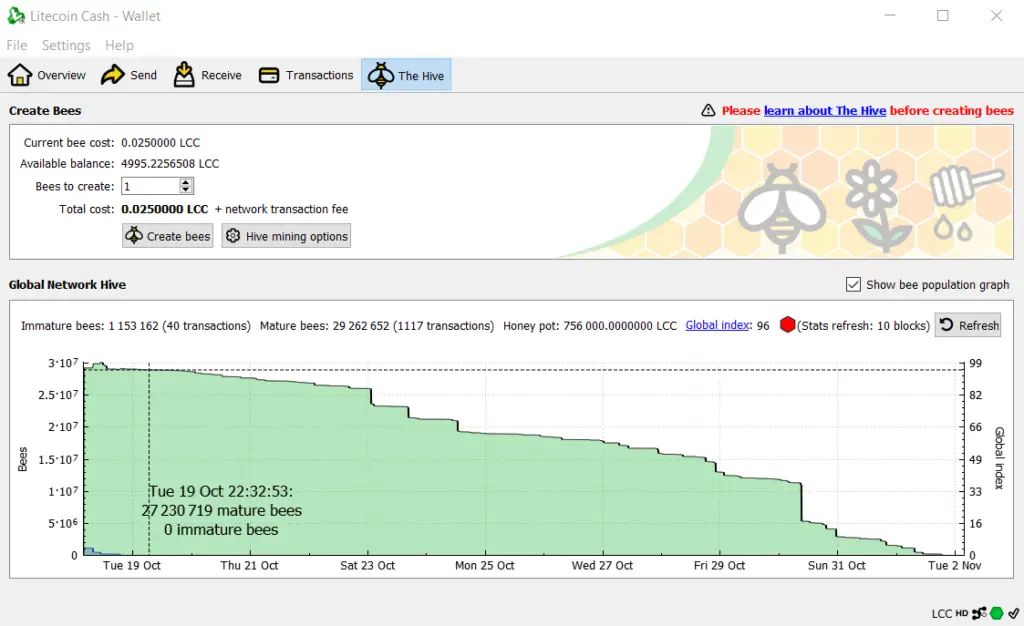Litecoin Cash is an innovative cryptocurrency that has three different ways of generating new coins. It first started with SHA-256 mining. A successful 51% attack in 2018 caused them to diversify by adding Hive mining and MinotaurX CPU mining was added later as a non-ASIC option.
I recently tried hive mining, and here’s what the experience was like for me.
With hive mining, you spend coins to create “bees”, which are in a pending queue for 24 hours and then active for two weeks. It essentially functions as a raffle with each bee equivalent to one raffle ticket. The person with the more tickets is more likely to win, but it functions like a random drawing, so you can find a block with just a single bee if you’re luck.
The amount of competition on the network is shown as the Global Index, and if you check the “show bee population graph” box on The Hive tab, you can see how many bees are queued up to join the network and what the expiration schedule of existing bees is. This should give you some idea how the difficulty will change initially, but there’s no way to tell how many competing bees will be created beyond 24 hours.

Bee Population and Global Index Graph
While hive mining, your wallet needs to be open and active, so it’s only a good idea to hive mine on a computer that’s always on.
Creating the bees is simple, just enter the total and click “Create Bees”. I created 10,000 bees at a cost of 250 LCC, or about $5.50 USD at the time I started. The cost changes with each halving to keep pace with changes in block rewards. It doesn’t cost anything extra to contribute a percentage of the bee cost to the community fund, so I did that.

Bee creation shows up as two separate transactions.
The Global Index was fairly low when I started, but quickly creeped up toward 100 as more bees were created by other people.

Starting with a low Global Index.

New Bees and a Rising Global Index.
The first 10 days were discouraging, with no blocks found and no indication that I would ever find a block. Then I found two blocks worth 93.75 LCC each in the same day, day 11.
First hive mined block. A victory!
After the process finished, those bees had generated 187.5 LCC, for a loss of 62.5 LCC (about $1.20 USD).
The hive mining guide on the Litecoin Cash website says that hive mining is very fast. Even so, I wonder whether hardware has any impact. Would a faster CPU, faster RAM, better network connection, or faster process creation make you more likely to find a block? My system was under moderate load since I was also using it for work during the day and play in the evening. I do not know whether proof-of-work mining on the same computer that you’re hive mining on has a negative impact on your ability to hive mine a block.
The wallet also crashed once during this process, and was offline for about 15 minutes, so that was also a factor.
After the bees expired, information about the bees disappeared. I didn’t see the “include expired bees” so I thought it was just gone, but a team member was kind enough to point that out on the Litecoin Cash Reddit.
I’ve never had any luck in contests, especially raffles, so I’m unlikely to try hive mining again unless I notice the difficulty being extremely low. Even so, it’s neat that it exists and my slightly-negative-income experience should not dissuade you from trying it. I wish more cryptocurrency projects would try new things like Litecoin Cash has been. Unfortunately, LCC’s experimentation was necessitated by a 51% attack, but in the long run they are stronger for it.
If you like this post, feel free to send me a little LCC at M8ubC3t6hKpV1BvB1HqnKaSeeC75WnuZBD